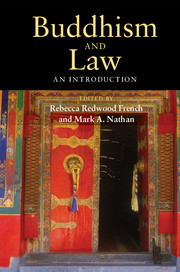Book contents
- Frontmatter
- Dedication
- Contents
- Maps and Illustrations
- Contributors
- Preface
- Abbreviations
- Introducing Buddhism and Law
- Part I The Roots of Buddhism and Law in India
- Part II Buddhism and Law in South and Southeast Asia
- Part III Buddhism and Law in East Asia
- 11 Buddhism and Law in China
- 12 The Ownership and Theft of Monastic Land in Ming China
- 13 Buddhism and Law in China
- 14 Buddhism and Law in Korean History
- 15 Buddhism and Law in Japan
- 16 Relic Theft in Medieval Japan
- Part IV Buddhism and Law in North Asia and the Himalayan Region
- A Selection of Readings
- Index
- References
14 - Buddhism and Law in Korean History
From Parallel Transmission to Institutional Divergence
Published online by Cambridge University Press: 05 August 2014
- Frontmatter
- Dedication
- Contents
- Maps and Illustrations
- Contributors
- Preface
- Abbreviations
- Introducing Buddhism and Law
- Part I The Roots of Buddhism and Law in India
- Part II Buddhism and Law in South and Southeast Asia
- Part III Buddhism and Law in East Asia
- 11 Buddhism and Law in China
- 12 The Ownership and Theft of Monastic Land in Ming China
- 13 Buddhism and Law in China
- 14 Buddhism and Law in Korean History
- 15 Buddhism and Law in Japan
- 16 Relic Theft in Medieval Japan
- Part IV Buddhism and Law in North Asia and the Himalayan Region
- A Selection of Readings
- Index
- References
Summary
Introduction
This chapter provides a brief overview of the relationship between Buddhism and law in Korea from transmission in the fourth century CE through the change of dynasties at the turn of the fourteenth century. Given the wide scope of time and the dearth of previous scholarship on this subject, this chapter can do little more than sketch the broad contours of the multifarious ways that Buddhist ideas, texts, institutions, and individuals intersected and interacted with secular law in Korean history. It begins with a consideration of the initial patterns in the transmission of Buddhism and written law to Korea, which roughly coincided, and then examines different aspects of their interconnections as the relationship developed over time. Although Buddhism and law were closely intertwined through much of this period, distinctions were gradually drawn between them leading to greater divergences and the increasing subordination of the former to the latter. Political changes in the late fourteenth century produced an onslaught of laws and legal measures designed to strip the monastic community of much of its property, rights, prestige, and power. The evidence suggests, however, that from a Buddhism and law perspective, the legal tools needed to suppress and marginalize monastic institutions had already been put in place much earlier. In other words, the radical reorientation in saṅgha-state relations at this time did not alter the fundamental structure of the relationship between Buddhism and law, although it did substantially change its character. This suggests that, while the relationship of Buddhism to law was closely related to the relationship of Buddhism to the state, the two were neither identical nor interchangeable.
- Type
- Chapter
- Information
- Buddhism and LawAn Introduction, pp. 255 - 272Publisher: Cambridge University PressPrint publication year: 2014
References
- 1
- Cited by



